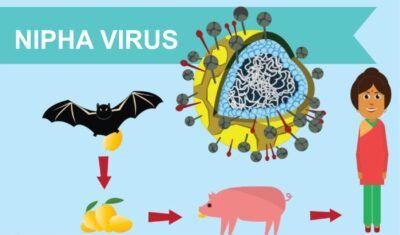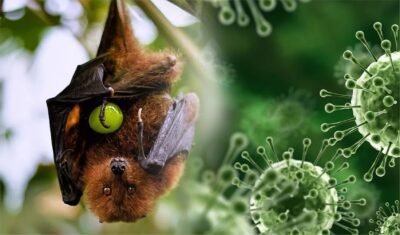Nipah Virus Kerala – What are its History & Symptoms

Nipah virus Kerala – a phrase that has struck fear and concern in the hearts of many. In recent years, the Nipah virus has made headlines in Kerala, India, due to sporadic outbreaks that have raised concerns among health authorities and the general public. The Nipah virus has been in the news recently due to the outbreak in Kerala, India. This article will delve into the history of the Nipah virus and its symptoms, shedding light on this potentially deadly pathogen.
Introduction
The Nipah virus is a zoonotic illness that can be spread from animals to people. It is a member of the Paramyxoviridae family, genus Henipavirus, and was first identified in 1999 during an outbreak among pig farmers in Malaysia and Singapore. The virus gets its name from Sungai Nipah, a Malaysian village where pig farmers became ill with encephalitis. Fruit bats are the virus’s primary host animals.
The State Health Department has confirmed five cases of Nipah virus infections in Kozhikode district, Kerala. The symptoms of Nipah virus infection range from asymptomatic infection to acute respiratory syndrome and fatal encephalitis (inflammation of the brain). After exposure and an incubation period of 5 to 14 days, illness presents with 3 to 14 days of fever and headache, followed by drowsiness, disorientation, and mental confusion. Within 24 to 48 hours, these signs and symptoms can develop into a coma.
Check This Also – How I can Increase my SexPower
History of the Nipah Virus
The Emergence in Malaysia 1999
The first recorded outbreak of Nipah virus infection occurred in Kampung Sungai Nipah, Malaysia. This deadly virus was transmitted to humans from pigs, signaling a concerning zoonotic potential. The inaugural outbreak in Malaysia resulted in 265 reported cases, with a staggering 40% mortality rate. This marked the beginning of a long battle against the virus.
2001 Bangladesh Outbreak
Bangladesh witnessed a devastating outbreak in 2001, with frequent occurrences in subsequent years. Fruit bats were identified as the primary reservoir, emphasizing the virus’s zoonotic nature.
2007 West Bengal
Cases Reported in Nadia district of West Bengal – 5 Patients died.
2018 Kozhikode Outbreak
Kozhikode 1st Nipah outbreak – 17 of the 18 confirmed cases died.

2019 Ernakulam
One Case reported in Ernakulam – Patient recovered.
2021 Kerala
One Case Found – Patient died.
Now 2023 Again in Kerala
Four Case Active – 2 Fatalities.
Symptoms of Nipah Virus Infection
Initial Symptoms
Nipah virus infection typically begins with flu-like symptoms, including fever, headache, muscle pain, and fatigue. These symptoms can be misleading, as they resemble those of common viral infections.
Progression of the Disease
More severe symptoms, such as the following, may appear as the infection worsens.
Encephalitis
One of the hallmark features of Nipah virus infection is its ability to cause encephalitis and inflammation of the brain. This can result in confusion, dizziness, and even coma in severe cases.
Respiratory Distress
Patients may also experience respiratory distress, characterized by cough, shortness of breath, and chest pain.
High Fatality Rate
It’s crucial to note that Nipah virus infection has a high fatality rate, often exceeding 70%. This makes early detection and treatment critical for survival.
How the Nipah Virus Spread
Transmission of NiV to humans may occur after direct contact with infected bats and pigs by consuming fruits eaten by infected bats and birds or through contact with other NiV-infected people. There is no vaccine for either humans or animals. Intensive supportive care is the main form of treatment for human instances.
Prevention and Control
To prevent infection, it is recommended to avoid exposure to sick pigs and bats and not eat fruits bitten by bats. Following the deaths of two individuals and the infection of three others, including a health worker in Kozhikode, by the brain-damaging Nipah virus, the Keralan government has stepped up its efforts to stop its spread.
Nipah virus epidemics must be stopped using multiple strategies:

1. Strict Hygiene Practices
Promoting good hygiene practices, especially in pig farms and among those in close contact with animals, is essential. Regular handwashing and wearing appropriate protective gear can help reduce the risk of transmission.
2. Surveillance and Early Detection
Early detection of Nipah virus cases is crucial to prevent its spread. Enhanced surveillance systems can help identify and isolate cases promptly.
3. Community Awareness
Educating communities about the virus, its symptoms, and preventive measures can empower individuals to protect themselves and their families.
4. Vaccination Research
Efforts are underway to develop vaccines against the Nipah virus, which could be a game-changer in preventing future outbreaks.
Conclusion
The Nipah virus in Kerala has been a cause for concern, given its history of outbreaks and high fatality rate. Understanding the virus, its symptoms, and preventive measures is crucial for safeguarding public health. Kerala’s experience with Nipah serves as a stark reminder of the ever-present threat of emerging infectious diseases.
FAQs (Frequently Asked Questions)
What are the primary hosts of the Nipah virus?
The primary hosts are fruit bats of the Pteropodidae family.
Is there a vaccine available for the Nipah virus?
Efforts are ongoing to develop a vaccine, but none is currently available for widespread use.
Can the Nipah virus be transmitted from person to person?
Yes, the Nipah virus can be transmitted through direct human-to-human contact.
What are the main symptoms of a Nipah virus infection?
Symptoms include fever, headache, drowsiness, and respiratory issues, which can progress to encephalitis in severe cases.
How can individuals protect themselves from the Nipah virus?
Preventive measures include avoiding contact with infected animals, practicing good hygiene, and ensuring safe food preparation.
